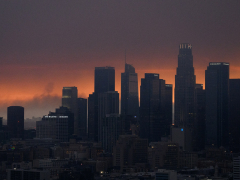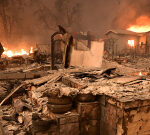At least five people have been killed and thousands of homes have been gutted in wildfires that have ravaged multiple parts of Los Angeles in California – the most populous state of the United States.
More than 130,000 residents in different neighbourhoods of Los Angeles city have been ordered to evacuate as the fires, which erupted on Tuesday, continue to rapidly spread, fuelled by high winds.
So how big are the fires at present, and how did they begin?
What started the California wildfires?
The first fire started in the Pacific Palisades neighbourhood of Los Angeles at 10: 30am (18: 30GMT) on Tuesday, according to California Department of Forestry and Fire Protection (Cal Fire).
Investigators are still trying to find out the exact trigger for the worst firestorm in recent memory, but a combination of factors might have created conditions optimal for a fire.
California generally experiences wildfires during June and July, and they can run until October, but the blaze has defied the calendar this year, erupting in January – the coldest of the winter months.
Southern California, the site of the fires, has been experiencing drought conditions and had not seen significant rainfall for months. Last year less than four percent of California was affected by drought compared with nearly 60 percent this year, according to the US drought monitor.
Climate change has contributed to an increase in the frequency, season length and burned area of wildfires, according to a report by the US Environmental Protection Agency (EPA).
So, dry conditions aided by Santa Ana winds – dry and hot winds common in the area – most likely caused the wildfires.
The dry desert air moves from the interior of the region towards the coast and offshore. It contributes to wildfires because it significantly reduces humidity in the environment due to its dry nature. This causes vegetation to become very dehydrated and susceptible to fire. Under these circumstances, any spark can start a fire, be it from a cigarette butt, vehicle or power line.
Gusts up to 100mph (160km/h) were recorded at higher elevations on Tuesday night, according to AccuWeather meteorologist Danielle Ehresman.
Besides dry vegetation, Los Angeles has other flammable materials such as low-hanging power cables and wooden telephone polls.
Santa Ana winds have been associated with extreme wildfires in California in the past, including the Woolsey fire in November 2018, which killed three people and razed 1,600 structures.
Experts, however, warn that weather conditions are dire this year.
“We really haven’t seen a season as dry as this one following a season as wet as the previous one – all of that extra abundant growth of grass and vegetation followed immediately by a wind event of this magnitude while it’s still so incredibly dry,” Daniel Swain, a climate scientist at University of California, Los Angeles, said on a livestream on Monday.
How big are the California wildfires?
Rapid spread
The fire started in Palisades located on the Pacific Ocean, and from there the blaze spread rapidly to other neighbourhoods. The second fire broke out in Eaton at about 6pm (02: 00 GMT) on Tuesday. A third fire also broke out the same day in Sylmar, in the San Fernando Valley northwest of Los Angeles, called the Hurst fire.
Five more fires broke out in California on Wednesday: the Lidia, Sunset and Woodley fires in Los Angeles; the Olivas fire in Ventura a




